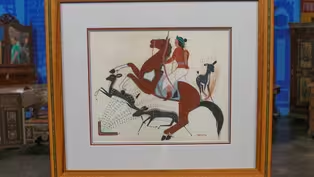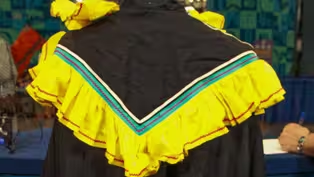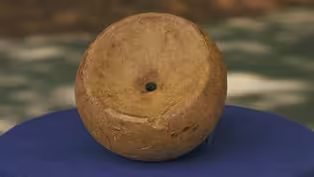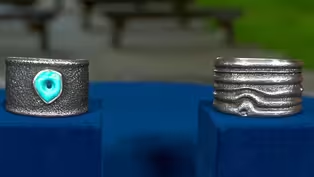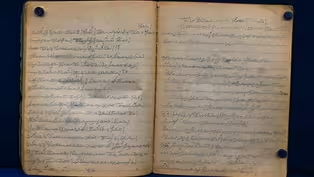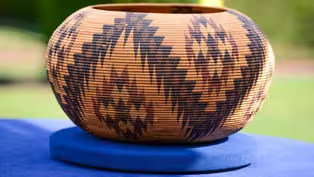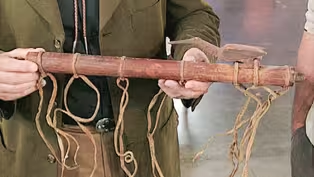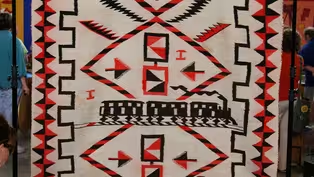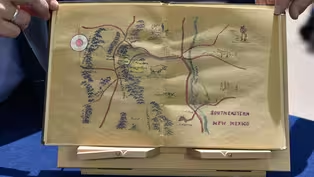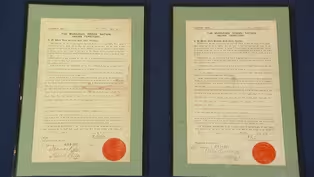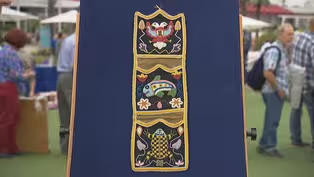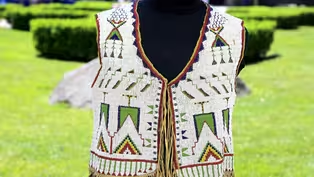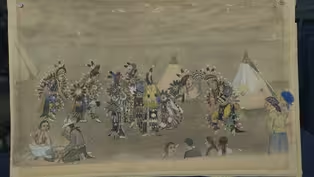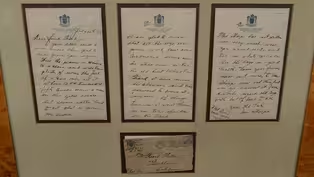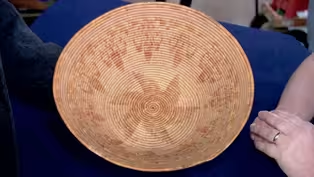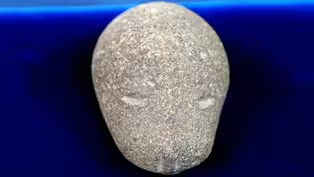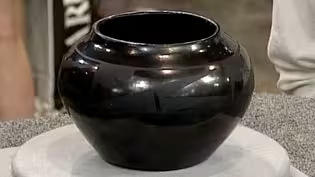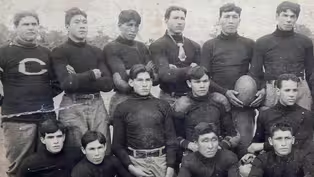
Appraisal: Ruth Muskrat Bronson Archive, ca. 1923
Clip: Season 28 Episode 23 | 4m 58sVideo has Closed Captions
Appraisal: Ruth Muskrat Bronson Archive, ca. 1923
See Bruce M. Shackelford appraise a Ruth Muskrat Bronson archive, ca. 1923, in Celebrating Native American Heritage.
Problems playing video? | Closed Captioning Feedback
Problems playing video? | Closed Captioning Feedback
Funding for ANTIQUES ROADSHOW is provided by Ancestry and American Cruise Lines. Additional funding is provided by public television viewers.

Appraisal: Ruth Muskrat Bronson Archive, ca. 1923
Clip: Season 28 Episode 23 | 4m 58sVideo has Closed Captions
See Bruce M. Shackelford appraise a Ruth Muskrat Bronson archive, ca. 1923, in Celebrating Native American Heritage.
Problems playing video? | Closed Captioning Feedback
How to Watch Antiques Roadshow
Antiques Roadshow is available to stream on pbs.org and the free PBS App, available on iPhone, Apple TV, Android TV, Android smartphones, Amazon Fire TV, Amazon Fire Tablet, Roku, Samsung Smart TV, and Vizio.
Buy Now
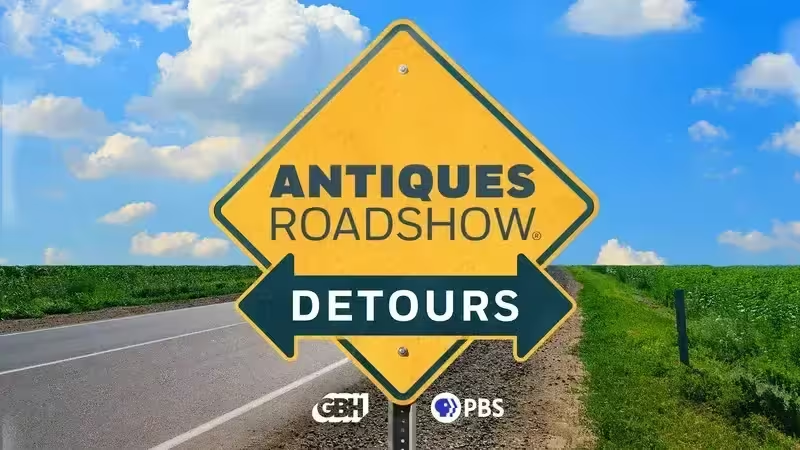
ANTIQUES ROADSHOW DETOURS
Ever wondered what happens to the treasures featured on America’s beloved ANTIQUES ROADSHOW after the cameras leave town? Host Adam Monahan tracks down the juicy afterlives of your favorite finds from PBS’s hit series.Providing Support for PBS.org
Learn Moreabout PBS online sponsorshipGUEST: This belonged to my great-great-aunt Ruth Muskrat Bronson.
She was a civil rights activist.
She was an author, a poet, a songwriter, an educator.
To me, uh, she is so special-- she was a woman before her time, and she did a lot of things for Native American people that we can all still be proud of today.
APPRAISER: What was her era, so to speak?
GUEST: She was born in 1897.
This picture was taken in 1923, when she was a junior in college at Mount Holyoke.
And this is at the White House in Washington, D.C. APPRAISER: Okay.
GUEST: This is my Aunt Ruth, and this is President Calvin Coolidge.
And this is a book that she presented to him that day.
And she also gave a speech that day.
APPRAISER: Is the dress that you're standing by the one she's wearing in that photograph?
GUEST: This is the dress that's in the photograph, yes.
APPRAISER: Okay.
And, and that's the same dress that's in this photograph.
Were the moccasins and the dress created for the presidential event?
GUEST: That's my understanding, yes.
They were intentionally not Cherokee items... APPRAISER: Mm-hmm.
GUEST: ...so that she could be representative of more than just her tribe and be representative of all American Indians.
APPRAISER: This is the speech that she delivered at the White House, is that right?
GUEST: Yes.
And to read through that speech, it gives me goosebumps.
She said such amazing things that President Coolidge invited her to come to the White House for lunch at a later date, which she did.
APPRAISER: In the speech, she tells who made the beadwork.
Both the moccasins and the dress were made here in Oklahoma by Cheyenne bead-workers.
The hides are brain-tanned deerskin, which were never inexpensive.
They were always, incredibly high price to get them.
They were difficult to make.
And I thought the moccasins might be Lakota because of the designs.
But then I got to looking, and there's a welt right here between the sole and the beaded uppers.
You notice that trait in lots of Cheyenne moccasins from Oklahoma, you know, the Southern Cheyennes.
Do you know what she was talking to the president for?
GUEST: Well, this was the Committee of One Hundred in 1923, and I believe she was asking for civil rights for Native American people.
APPRAISER: Right.
GUEST: And also fighting for Native Americans in the laws that were be, being created at that time and talking about the "Indian Problem."
And she wanted the president to hear from an Indian what the real Indian Problem was, and it wasn't what the other people were calling the Indian Problem.
She wanted everyone to accept Native Americans as Americans and to allow them to be educated just like everyone else.
APPRAISER: Yeah, I saw in the letter, she's asking for education for all.
GUEST: Yes.
APPRAISER: Where did she live?
GUEST: She was from Grove, Oklahoma.
APPRAISER: Oh, yeah.
GUEST: She was my great-grandmother's sister, and that's where our whole family was from.
That's where our allotment land, uh, we still have that allotment land, um, but she, she lived in Washington, D.C. She worked there for the government, for the B.I.A., and then she retired in, uh, Phoenix, Arizona.
She was helping different tribes her entire life.
When she passed away, I believe she was in Arizona working for water rights for tribes out there.
APPRAISER: Oh, yeah, that's a big deal.
GUEST: Yes.
APPRAISER: She's asking for what we consider basic human rights...
GUEST: Absolutely.
APPRAISER: ...in this country today in the '20s.
And, and after that, you get the Depression, and things really got bleak.
Now people have awakened to these situations, but they didn't do it without a pushback.
And that's why a lot of rules have been passed, laws have been enacted, everything from the Native American Sovereignty acts to NAGPRA, the Native American Graves Protection and Repatriation Acts.
And they protect this cultural patrimony that's been handed down, in your case, through your family, but also in national input.
And this was the early days of all that.
These were the people that pushed that to try to make it happen.
When you brought this dress in and the moccasins, I looked down and I said, "Yeah, nice moccasins, nice dress."
In this condition, and mainly because they're late, if you were going to see these things at auction, you'd expect 'em to bring $800 to $1,200.
But that's not what's here.
That's not what this is about.
This is about, this woman wore these things to represent a pan-culture, almost, that spread across the United States that she was fighting for, for rights for.
When you start looking at it from that point of view-- her meeting with the president, the original speech-- and I think you're talking, for all of that you have here-- and you have more, you have more archival material, more photographs-- if you were to bring these up for insurance, it gets more like $8,000 to $12,000.
GUEST: Wow!
And these things are priceless to our family.
APPRAISER: Oh, I'm sure.
GUEST: So, yes.
Appraisal: Narciso Abeyta (Ha So De) Painting, ca. 1935
Video has Closed Captions
Clip: S28 Ep23 | 2m 41s | Appraisal: Narciso Abeyta (Ha So De) Painting, ca. 1935 (2m 41s)
Appraisal: Seminole Circuit Court Judge's Robe, ca. 1955
Video has Closed Captions
Clip: S28 Ep23 | 23s | Appraisal: Seminole Circuit Court Judge's Robe, ca. 1955 (23s)
Appraisal: Mississippian Granite Discoidal, ca. 1000 - 1500
Video has Closed Captions
Clip: S28 Ep23 | 1m 47s | Appraisal: Mississippian Granite Discoidal, ca. 1000 - 1500 (1m 47s)
Appraisal: 1970 Charles Loloma Sterling Silver Bracelets
Video has Closed Captions
Clip: S28 Ep23 | 3m | Appraisal: Charles Loloma Sterling Silver Bracelets, ca. 1970 (3m)
Appraisal: Yup'ik Language Manuscript, ca. 1895
Video has Closed Captions
Clip: S28 Ep23 | 3m 19s | Appraisal: Yup'ik Language Manuscript, ca. 1895 (3m 19s)
Appraisal: Carrie Bethel Basket, ca. 1958
Video has Closed Captions
Clip: S28 Ep23 | 5m 1s | Appraisal: Carrie Bethel Basket, ca. 1958 (5m 1s)
Appraisal: Plains Indian Courting Flute, ca. 1870
Video has Closed Captions
Clip: S28 Ep23 | 1m 44s | Appraisal: Plains Indian Courting Flute, ca. 1870 (1m 44s)
Appraisal: Navajo Transitional Pictorial Weaving, ca. 1890
Video has Closed Captions
Clip: S28 Ep23 | 2m 29s | Appraisal: Navajo Transitional Pictorial Weaving, ca. 1890 (2m 29s)
Appraisal: 'A Courier in New Mexico' book 1936
Video has Closed Captions
Clip: S28 Ep23 | 3m 37s | Appraisal: 'A Courier in New Mexico' Book, ca. 1936 (3m 37s)
Appraisal: 1903 & 1905 Muskogee Creek Nation Allotment Deeds
Video has Closed Captions
Clip: S28 Ep23 | 1m 56s | Appraisal: 1903 & 1905 Muskogee Creek Nation Allotment Deeds (1m 56s)
Appraisal: Tlingit Wall Pocket, ca. 1880
Video has Closed Captions
Clip: S28 Ep23 | 1m 22s | Appraisal: Tlingit Wall Pocket, ca. 1880 (1m 22s)
Appraisal: Sioux Beaded Vest, ca. 1876
Video has Closed Captions
Clip: S28 Ep23 | 3m 28s | Appraisal: Sioux Beaded Vest, ca. 1876 (3m 28s)
Appraisal: Ernest Spybuck Painting, ca. 1915
Video has Closed Captions
Clip: S28 Ep23 | 25s | Appraisal: Ernest Spybuck Painting, ca. 1915 (25s)
Appraisal: 1933 Jim Thorpe Handwritten Letter
Video has Closed Captions
Clip: S28 Ep23 | 4m 35s | Appraisal: 1933 Jim Thorpe Handwritten Letter (4m 35s)
Appraisal: Mission Indian Basket, ca. 1920
Video has Closed Captions
Clip: S28 Ep23 | 1m 3s | Appraisal: Mission Indian Basket, ca. 1920 (1m 3s)
Appraisal: Woodlands Carved Ash Burl Bowl, ca. 1800
Video has Closed Captions
Clip: S28 Ep23 | 3m 21s | Appraisal: Woodlands Carved Ash Burl Bowl, ca. 1800 (3m 21s)
Appraisal: Aleut Stone Oil Lamp
Video has Closed Captions
Clip: S28 Ep23 | 3m 53s | Appraisal: Aleut Unungan Stone Oil Lamp (3m 53s)
Appraisal: Hopi Pottery Seed Jar, ca. 1908
Video has Closed Captions
Clip: S28 Ep23 | 33s | Appraisal: Hopi Pottery Seed Jar, ca. 1908 (33s)
Appraisal: Maria Martinez Pot, ca. 1925
Video has Closed Captions
Clip: S28 Ep23 | 2m 11s | Appraisal: Maria Martinez Pot, ca. 1925 (2m 11s)
Appraisal: Carlisle Indian School Archive, ca. 1910
Video has Closed Captions
Clip: S28 Ep23 | 2m 46s | Appraisal: Carlisle Indian School Archive, ca. 1910 (2m 46s)
Providing Support for PBS.org
Learn Moreabout PBS online sponsorship
- Home and How To

Hit the road in a classic car for a tour through Great Britain with two antiques experts.













Support for PBS provided by:
Funding for ANTIQUES ROADSHOW is provided by Ancestry and American Cruise Lines. Additional funding is provided by public television viewers.


